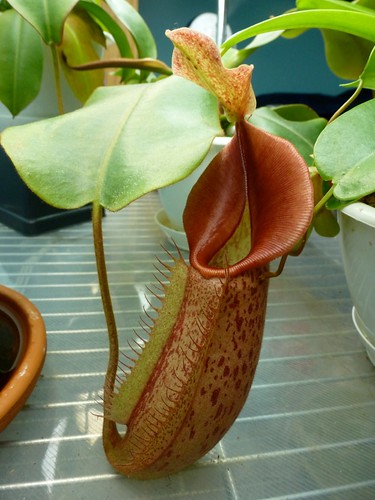|
|
Post by mikuláš on Sept 28, 2011 15:46:31 GMT -10
The Song of Melancholy hybrid has been around for a while now, and having been inspired by the recent veitchii hybrid thread & ellisonk001's rolling picture thread, I thought it might be interesting to have a thread where we could compare our different clones. If I recall correctly, SoM was originally bred by Michael (aka rainforest). The mother was boschiana, and there are believed to be 2 fathers, based on what Michael had blooming at the time: spectabilis x veitchii and veitchii. Sam has grown out a number of these and posted some stunning pics of them here. I'll get started by doing gross injustice to my plants with my poor photography. Moving the plants out of their indoor grow area for a proper photo shoot is difficult, so these will have to suffice. Clone 1: probably boschiana x (spectabilis x veitchii). About 2 ft. /0.7m across, it's a steady grower with long-lasting pitchers. The peristome starts out striped, but the stripes become harder to see as the peristome darkens.   The whole plant:  Clone 2: boschiana x veitchii. The peristome darkens with age and does not reflex. Older pitcher on the left.   In good light the peristome on this one gets very, very dark. Both grow well in my intermediate conditions and make long tendrils ('cuz boschiana makes everything better  ) Any others out there? |
|
|
|
Post by ellisonk001 on Sept 29, 2011 7:54:28 GMT -10
|
|
|
|
Post by leilani on Sept 29, 2011 13:41:08 GMT -10
I'm not so sure about the second parent having been veitchii. The spectabilis x veitchii plants are easy to recognize but the second bunch looks more like something with spathulata.
|
|
|
|
Post by whimgrinder on Oct 11, 2011 8:21:52 GMT -10
|
|
|
|
Post by pills23 on Jan 14, 2013 9:38:43 GMT -10
Hi Sam (and everyone), I was hoping you could give some insight into the suspected parentage of my SoM. As a bit of background, I purchased this plant from the Leilani table at the NECPS show back in 2011. I really haven't seen much variability in the pitchers. The ones that were on the plant when I got it had a bit more green in the body and the peristome rolled back a bit more than the subsequent pitchers in my care. Not surprising, since our growing conditions are very different. However, the general morphology of the pitchers have been nearly identical. I understand that there were supposedly 2 males used in this cross (at least one of which is likely unknown), but in both cases N boschiana is listed as the female. N boschiana seems very evident in many of the striped pitchers that I've seen. However, my plant has never shown the characteristic "hip" that is evident in the species - not even a suggestion of it. This seems surprising, given it's the female parent. My suspicion is that this is an entirely different cross, but I'd love to have your input. Thanks! Below are recent and older photos. Most recent pitcher (opened a month or so ago):    An older pitcher (4/2012), shortly after opening:  One of the original pitchers that was on the plant when I purchased it:  |
|
|
|
Post by mikuláš on Jan 14, 2013 10:56:46 GMT -10
Do any of the SoMs show the "hip" of boschiana? I don't think any of mine do. That's a very nice clone you have, pill23. Just for fun, here's an update on the first clone I had pictured:  |
|
|
|
Post by pills23 on Jan 14, 2013 11:21:28 GMT -10
Thanks - as are yours! I'm pleased with mine. Yes, it seems many of the images I see in the forums show the "hip" or a suggestion of one (more peanut-shaped). If you look at CPPhotoFinder you can see some. It's very noticeable in this one: leilaninepenthes.com/Images/2012-7-24_quelchii_Nepenthes%20272.jpgActually I just took a look at some other crosses where N boschiana was the female, and most of those also show a clear hip, or at least a suggestion of one. |
|
|
|
Post by Noa_F on Jan 14, 2013 12:17:20 GMT -10
If I remember correctly, there was speculation that the second male parent could be N.[(Mixta x maxima) x veitchii] x (northiana x veitchii). It was a male plant that Michael had at the time and could account for the strong veitchii influence. We may never know for certain, but they sure are nice plants!
|
|